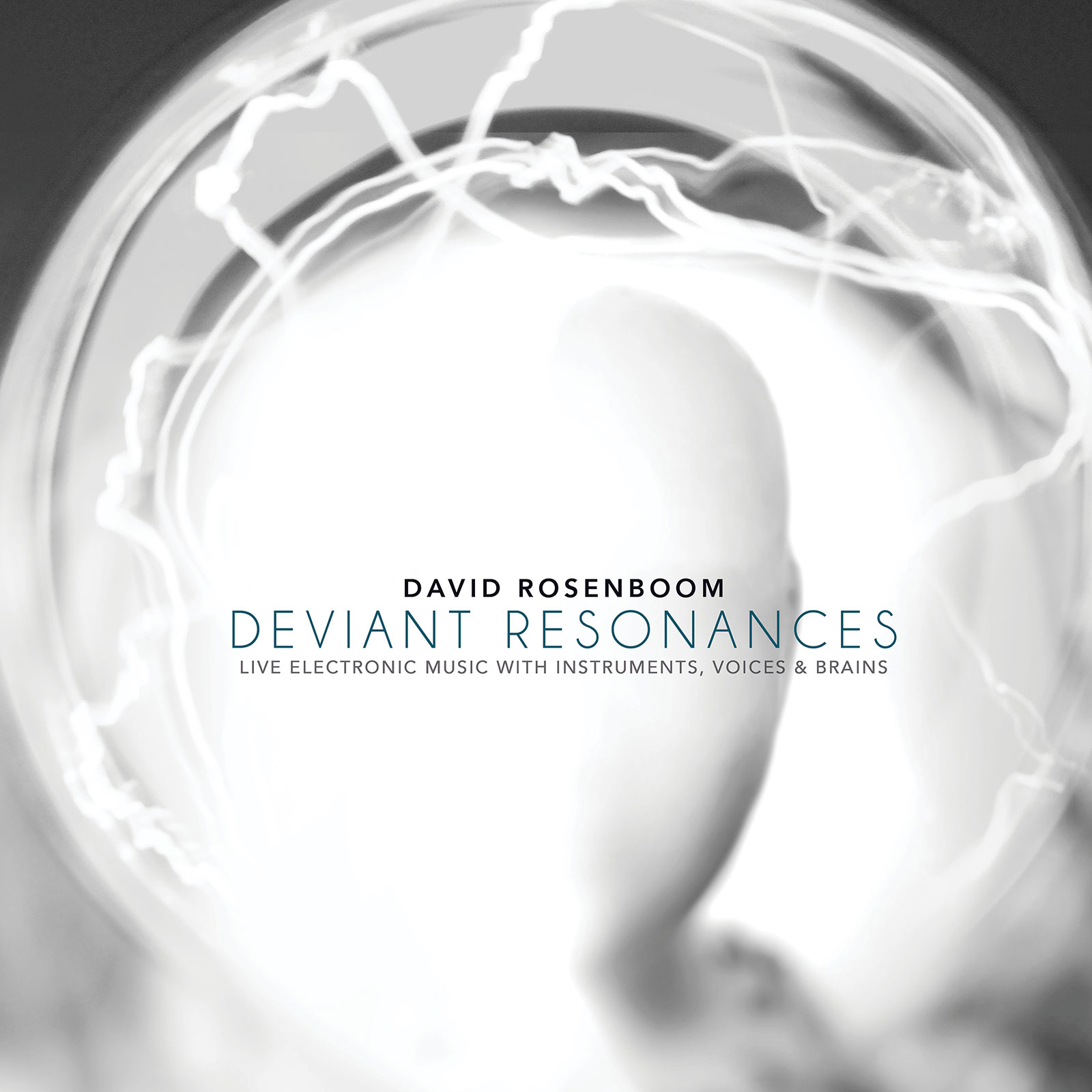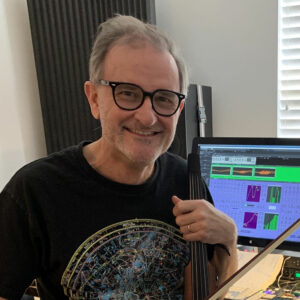
Share Album:
Deviant Resonances
David Rosenboom composer
DEVIANT RESONANCES carries the concept of “creative listening” into new dimensions. In addition to the unconventional ways in which the everyday listener is called on to interpret the music, composer David Rosenboom literally uses the action of “listening” as an instrument.
The first track, Portable Gold and Philosophers’ Stones (Deviant Resonances) (2015), is an epic piece lasting over 35 minutes. Rosenboom achieves a resonant sound by analyzing electrical signals coming from the brains of two imaginative performers. A third performer calibrates a computer system to the responses of what he calls “imaginative listening.” This system adapts to the brainwave activity of the first two performers and builds a symphony ranging from quiet beginnings to climaxing crescendos.
The resulting sound is simultaneously relaxing and curious. The calming flow of resonance from the brainwaves creates the illusion that time is being slowed down. In this calm, however, one can’t help but wonder at the revolutionary use of brain functions as music and the potentiality of the organ inside each of our heads. The ethereal droning with occasional flaring sparks and pops evokes a timeless, spaceless experience which listeners from anywhere in the world can explore.
The album continues with its experimental approach to the reverberation of space using electronics and computer algorithms in tandem with live instruments. Though only half the length of Portable Gold, compositions like The Right Measure of Opposites and Earth Encomium explore the same “nothingness” of space but offer grounding in the physical world through instruments like live piano.
The album concludes with The Experiment and Four Lines (String Quartet). They are the only tracks to use voice and strings, respectively. These compositions call on attentive listeners to experience a constant volley between electronic and conventional instruments as they warp time and space, embellish the soundscape, and attempt to achieve a perfect synchrony.
Listen
Stream/Buy
Choose your platform
Track Listing & Credits
| # | Title | Composer | Performer | |
|---|---|---|---|---|
| DISC ONE | ||||
| 01 | Portable Gold and Philosopher's Stones (Deviant Resonances) | David Rosenboom | David Rosenboom, electronics, computer algorithms; Sarah Belle Reid, Micaela Tobin - active imaginative listening brainwave performers | 35:20 |
| 02 | Layagnanam | David Rosenboom, Trichy Sankaran | Trichy Sankaran, mrdangam; David Rosenboom, electronics, computer algorithms | 7:07 |
| 03 | Bell Solaris: III. The Right Measure of Opposites (Version for 2 Pianos) | David Rosenboom | David Rosenboom, two Yamaha Disklavier™ pianos, electronics, computer algorithms | 14:18 |
| DISC TWO | ||||
| 01 | Earth Encomium - Nothingness Is Unstable | David Rosenboom | David Rosenboom, electronics, computer algorithms, field recordings, piano, Yamaha Disklavier™ | 15:56 |
| 02 | Music for Unstable Circuits (+ Piano) | David Rosenboom | David Rosenboom, piano, electronics, computer algorithms | 12:47 |
| 03 | Hopscotch "The Experiment" | David Rosenboom | David Rosenboom, electronics, computer algorithms; Marja Liisa Kay, soprano; David Castillo, baritenor; Sarah Belle Reid, Micaela Tobin, Gillian Rae Perry, Amy Knoles - active imaginative listening brainwave performers | 18:10 |
| 04 | Four Lines (Version for String Quartet) | David Rosenboom | Andrew McIntosh, violin; Andrew Tholl, violin; Linnea Powell, viola; Ashley Walters, cello; David Rosenboom, electronics, computer algorithms | 17:09 |
Electronics employed included: Muse™ brainwave sensing headbands, Buchla 200 Series analog modules, Apple computers, and composer’s custom built circuits.
Software used included: Reaktor, Muse I/O, HMSL (Hierarchical Music Specification Language) (Burk, Polansky, and Rosenboom), and Touché II (Rosenboom and Zwartjes) inspired by Touché (Buchla and Rosenboom).
Special thanks to InteraXon, Inc. for Muse™ brainwave sensing headbands and Yamaha Corporation of America and Yamaha Artist Services, Inc. for piano used in these recordings and support of Rosenboom’s work with the Disklavier™.
Supported in part by the Richard Seaver Distinguished Chair in Music at CalArts.
David Rosenboom is a Yamaha Artist.
All compositions Copyright © David Rosenboom and The David C. Rosenboom 2013 Trust 1968 through 2018. Published by David Rosenboom Publishing (BMI).
Recording Copyright ℗ David Rosenboom and The David C. Rosenboom 2013 Trust 2019. All rights reserved.
DISC 1
TRACK 1
Recorded August 7, 2018 at the composer’s studio in Valencia CA
Recording, editing, and mixing engineer David Rosenboom
TRACK 2
Recorded April 19, 1990 in live performance at Merkin Concert Hall in New York
Recording engineer Rob Rapley, Classic Sound
Editing and mixing engineer David Rosenboom
TRACK 3
Recorded August 22, 2018 in The Wild Beast music pavilion at Herb Alpert School of Music, California Institute of the Arts in Valencia CA
Recording engineer Alberto Cruz
Editing and mixing engineer David Rosenboom
DISC 2
TRACK 1
Live parts recorded August 22, 2018 in The Wild Beast music pavilion at Herb Alpert School of Music, California Institute of the Arts in Valencia CA with subsequent sessions in the composers studio and field recordings from previous dates.
Recording engineer Alberto Cruz
Editing and mixing engineer David Rosenboom
TRACK 2
Recorded August 22, 2018 in The Wild Beast music pavilion at Herb Alpert School of Music, California Institute of the Arts in Valencia CA
Recording engineer Alberto Cruz
Editing and mixing engineer David Rosenboom
TRACK 3
Recorded August 9, 2018 in the composer’s studio in Valencia CA
Recording, editing, and mixing engineer David Rosenboom
TRACK 4
Recorded September 6, 2018 in the Dizzy Gillespie Digital Recording Studio at Herb Alpert School of Music, California Institute of the Arts in Valencia CA
Recording engineer John Baffa
Assistant recording engineer Alberto Cruz
Editing and mixing engineer David Rosenboom
Executive Producer Bob Lord
Executive A&R Sam Renshaw
A&R Danielle Lewis
Vice President, Audio Production Jeff LeRoy
Mastering Shaun Michaud
Production Engineer Lucas Paquette
Art Director Brett Picknell
Design Ryan Harrison, Edward A. Fleming
Publicity Patrick Niland
Artist Information

David Rosenboom
David Rosenboom is a post-genre composer-performer, interdisciplinary artist, author, and educator known as a pioneer in American experimental music. Since the 1960s, his multi-disciplinary work has traversed ideas about spontaneously evolving musical forms, languages for improvisation, new techniques in scoring, cross-cultural and large-form collaborations, performance art and literature, interactive multimedia and new instrument technologies, generative algorithmic systems, art-science research and philosophy, and extended musical interface with the human nervous system. He was Dean of The Herb Alpert School of Music at California Institute of the Arts from 1990 through 2020, where he now holds the Roy E. Disney Family Chair in Musical Composition.
David Castillo
David Castillo is a Los Angeles-based singer often seen and heard in major productions around LA with the Los Angeles Philharmonic, LA Master Choral, LA Opera, The Industry, and others. He has also appeared with The Cleveland Orchestra, New Orleans Opera, in Off-Broadway productions, and in many more contexts.
davidthesinger.com
Marja Liisa Kay
Marja Liisa Kay is a soprano dedicated to the performance and promotion of contemporary music, and who enjoys singing works of all genres. She has performed widely in major productions. She studied at Chapman University, the University of York, and California Institute of the Arts.
marjaliisakay.com
Amy Knoles
Amy Knoles has been a headliner on major festivals throughout the world for many years. She is a renowned percussionist-composer and a specialist in electronic percussion. She is a faculty member in the Herb Alpert School of Music at CalArts, where she is an Associate Dean and holds the Larry Levine Chair in Contemporary Music.
amyknoles.org
Andrew McIntosh
Andrew McIntosh is a Los Angeles-based composer/violinist/violist/baroque violinist. He has a multifaceted career spanning solo, chamber, and early music engagements across the United States and in Europe. He currently teaches violin, viola, and composition in the Herb Alpert School of Music at CalArts.
septimalcomma.com
Gillian Rae Perry
Gillian Rae Perry is a skilled composer-performer currently pursuing graduate studies in the Herb Alpert School of Music at CalArts. She has also studied in Paris with the European American Musical Alliance and at Southern Methodist University in Texas.
gillianraeperry.com
Linnea Powell
Linnea Powell enjoys a multifaceted career as a freelance violist in and around the Los Angeles area, performing regularly as an orchestral, chamber, and studio musician. An avid interpreter of new chamber music, Powell is a member of the Los Angeles new music collective Wild Up and recently founded Aperture Duo with violinist Adrianne Pope.
apertureduo.com
Sarah Belle Reid
Sarah Belle Reid is a Canadian performer-composer currently pursuing doctoral studies in the Herb Alpert School of Music at Calarts, where she also teaches. She specializes in trumpet and electronics, modular synthesis, and alternate forms of graphical notation for composition and improvisation. She is co-developer of the Minimally Invasive Gesture Sensing Interface (MIGSI) for trumpet.
sarahbellereid.com
Trichy Sankaran
Trichy Sankaran is a world-renowned percussion virtuoso, Indian music scholar, composer, and the founding director of Indian music studies at York University in Toronto, where he is now Emeritus Professor. His extensive career has taken him around the world, and his work is disseminated through a wide array of performances, publications, and recordings.
trichysankaran.com
Andrew Tholl
Andrew Tholl is a Los Angeles-based violinist, composer, drummer, and improviser. He has been commissioned by various groundbreaking performing groups and performed in a wide array of international venues. He has taught at the University of California in Santa Barbara, California Institute of the Arts, and several other institutions.
andrewtholl.com
Micaela Tobin
Micaela Tobin is a soprano, sound artist, and teacher based in Los Angeles, who specializes in contemporary opera and experimental voice, composing under the moniker “White Boy Scream.” She also currently teaches voice in the Herb Alpert School of Music at CalArts.
micaelatobin.com
Ashley Walters
Ashley Walters maintains a uniquely diverse career, performing music that blurs the boundaries between classical, avant-garde, and jazz. She is known for tackling virtuosic, demanding works and collaborating with composers. She has performed throughout the United States and on many international stages.
ashleywalterscello.com
Erin Young
Erin Young is an active writer, literary agent, and freelance editor in the greater Los Angeles area. She was one of the writers who helped create the libretto for Hopscotch. She has been an editor for important literary magazines and has worked with numerous critically acclaimed authors.
eyedits.com
Notes
Among the through lines connecting the elements of what may seem to be an inexplicably diverse landscape of intentions in my music, metaphors associated with resonant emergence ring again and again. Investigations into resonances enabling palpable substance to exist in the universe, resonant reinforcement of behaviors within and among complex societies, and subtle resonant tracings of thinking, knowing, and believing permeate the propositional models of my compositional practice. Yet deep inside these phenomena reside fundamental, natural uncertainties hugging all borders presumed to differentiate one thing from another. Inspiring, unpredictably deviant, spontaneous resonances often balloon and flower there. Viewed with venturesome openness, these departures from what is presumed to be knowable can fuel joyfully creative discoveries and potentialities for newness and rebirth.
The works contained in this album traverse broad musical territories, to be sure. Yet, all can be knit together with the yarn of this thinking. They are examples of what I call propositional music, an approach to composing that admits building proposed models of worlds, universes, evolution, brains, consciousness, or whole domains of thought and life, and then proceeding to make dynamical musical embodiments that invite us to experience and explore them in spontaneously emerging, sonic forms. Key to this is maintaining openness to co-communicative emergence among composers, performers, interactive and adaptive instruments, systems of memories and histories, and perhaps most importantly, actively imaginative, creative listeners. Listeners are encouraged to be co-creators, who can regard listening as co-composing and as active participation in manifesting shared musical universes.
— David Rosenboom / October 2018
